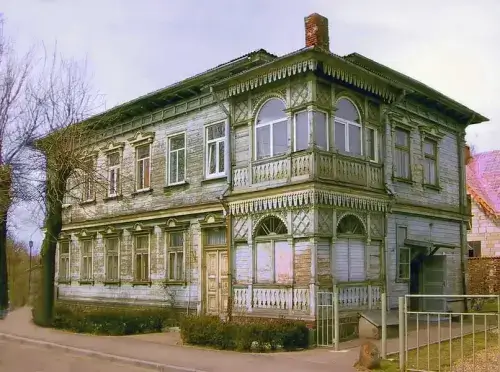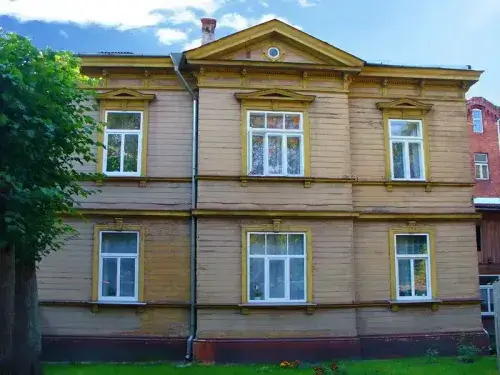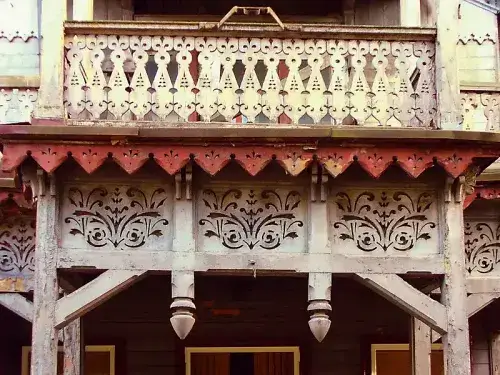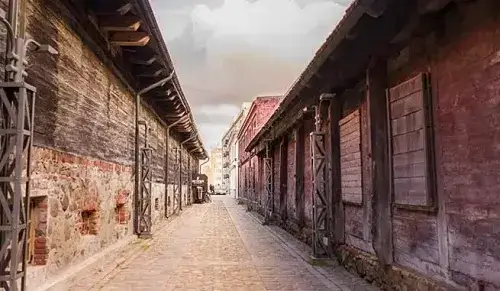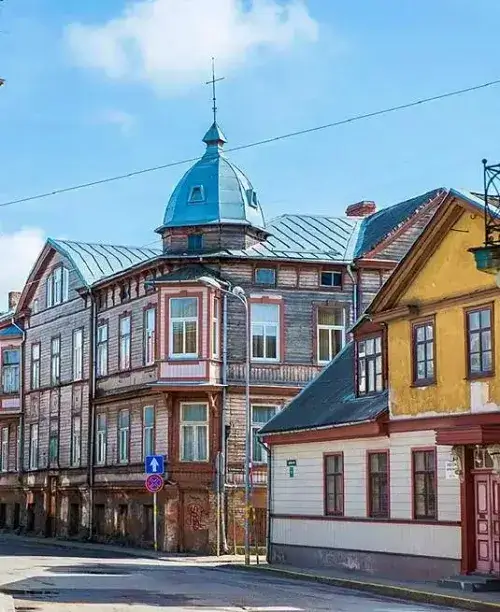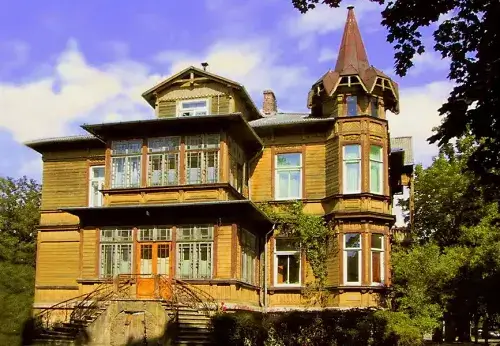Liepāja’s Architectura. Latvia, a gem nestled in the Baltic region, boasts a rich tapestry of history and culture, vibrantly reflected in its architecture. The city of Liepāja (1253), in particular, stands as a testament to this legacy, showcasing a diverse range of architectural styles that narrate its captivating past.
This text delves into the fascinating world of Liepāja’s old architecture, highlighting its significance, the invaluable contributions of architect Paul Max Bertschy, and the unique charm of its wooden buildings.
Liepāja’s Architectura, The Enduring Charm of Liepāja’s Old Architecture.
Liepāja’s old architecture is not merely a collection of buildings; it’s a living museum, deeply intertwined with the city’s identity and its residential housing stock.
Recognizing their immense historical and architectural value, the Liepāja City Council has taken proactive measures, incorporating these structures into a protected list of historically and architecturally significant buildings and complexes.
Furthermore, certain residential buildings have been designated as national monuments since March 26, 2001, underscoring their importance as mirrors of past eras that must be preserved for future generations.
When one compares the captivating older residences with the more utilitarian structures erected during the Soviet era, the aesthetic appeal of Liepāja’s historical buildings becomes immediately apparent. Adorned with intricate architectural elements, each structure reflects the architect’s thoughtful pursuit of beauty.
There is no doubt that Liepāja’s old architecture is a vital cultural and historical heritage that warrants unwavering preservation. The need for skilled restoration work is paramount, imagine these venerable buildings, once restored to their former glory, shining brightly with renewed splendor, inspiring awe for generations to come.
A small catalog of house images, perhaps akin to the one mentioned, could prove invaluable in guiding and supporting efforts to preserve these magnificent structures.
The sheer age of some of these buildings is remarkable; the oldest wooden edifices in the city date back to the 17th century. Kungu Street serves as an excellent example, having been the city’s main thoroughfare in the 17th century.
A unique complex of buildings, including the renowned Mrs. Hoijer’s Inn where Russian Tsar Peter I stayed in 1697, still stands at Kungu Street 24 and its inner courtyard. This enduring presence of 17th-century architecture offers a tangible link to Liepāja’s earliest days.
Paul Max Bertschy: A Visionary Architect’s Legacy in Liepāja
No discussion of Liepāja’s architectural heritage would be complete without acknowledging the profound impact of Paul Max Bertschy, arguably the city’s most influential architect of all time. For over three decades, Bertschy shaped the urban fabric of Liepāja, and his enduring legacy is still vividly apparent on its streets today.
Born in Germany in 1840, P.M. Bertschy initially worked in Riga and Daugavpils upon his relocation to Latvia. However, a pivotal invitation from Karl Gottlieb Uhlich, the head of Liepāja City, brought him to Liepāja in 1870.
For an impressive 31 years, Bertschy served as the city’s chief architect, a period during which he designed and oversaw the construction of a substantial number of public and private buildings.
The architectural contributions of Bertschy and his sons continued to define Liepāja’s visual identity until the tragic events of 1941 and 1944, when significant portions of Liepāja’s most beautiful architecture were reduced to rubble.
Despite these devastating losses, more than 70 of Bertschy’s designed and constructed buildings still grace Liepāja today.
Many of these have undergone significant restoration, ensuring their continued presence as a testament to his vision. In recognition of Bertschy’s immense contributions, residents have affixed plaques bearing his signature to the buildings he designed, a subtle yet powerful tribute to his enduring influence.
Bertschy’s architectural style is distinct, characterized primarily by the use of red bricks or a combination of materials such as bricks and plaster, or fieldstones and bricks.
With what might seem like a simple material… the red brick, Bertschy skillfully imparted a beautiful architectural character to the city. This approach demonstrates how a talented architect can transform common materials into visually striking and enduring structures.
Architectural Styles and Noteworthy Examples.
Bertschy’s “two-color building” group, often featuring contrasting brickwork and plaster, drew inspiration from Italian architectural models.
A prime example of this stylistic approach, executed with exceptional decorative sensibility, was the Liepāja Stock Exchange building, constructed between 1885 and 1887. This relatively small two-story building, with its five bay axes, stood as one of the most ornate among Bertschy’s Italian Neo-Renaissance constructions.
Though modest in size and without excessive ornamentation, the Liepāja Stock Exchange was a balanced and harmonious reflection of the architectural sensibilities of its time. Regrettably, this beautiful building was destroyed during World War II, a significant loss to Liepāja’s architectural heritage.
Let’s explore a few more examples of Liepāja’s old architecture: you can find a visual catalog showcasing some of these historical gems at: https://aspekti.top/veca-liepaja-arhitektura/
The Rich Tapestry of Liepāja’s Wooden Architecture.
Liepāja’s wooden architecture is incredibly diverse and steeped in history. As mentioned earlier, the oldest wooden buildings in the city date back to the 17th century, with Kungu Street being a prime example of this enduring legacy.
The complex at Kungu Street 24, including the famous Mrs. Hoijer’s Inn where Peter I of Russia stayed in 1697, now houses a museum showcasing 17th-19th century interiors, offering a unique glimpse into the past.
A significant aspect of Liepāja’s wooden architecture is the so-called “workers’ wooden houses,” built in the late 19th and early 20th centuries.
These are largely simple two-story structures, yet each one often surprises with small, intricate wooden details on its facade, or doors and window frames adorned with exquisite carvings.
Such buildings can be found in Jaunliepāja and near Lake Liepāja, on streets like Bērzu, Apšu, Ezera, Bernātu, and others. These humble yet charming dwellings offer a glimpse into the everyday lives of the city’s working class during that period.
In stark contrast, near Jūrmala Park, one can find truly opulent wooden buildings constructed in the Swiss style. These elaborate structures feature delicate wood carvings on balconies, stair railings, and facades, showcasing a higher degree of craftsmanship and decorative flair.
The most luxurious examples of wooden architecture are preserved on Dzintaru, Liepu, Peldu, Hika, and Vites Streets – areas that once served as summer cottage districts. These grand wooden villas speak to a different facet of Liepāja’s past, reflecting the leisure and prosperity of a bygone era.
Discovering Liepāja’s Architectural Wonders.
To truly appreciate the beauty and historical significance of Liepāja’s architecture, embark on a walking tour. To make your exploration easier, a map with marked objects is available, guiding you through the city’s architectural treasures.
You can access this map here: https://mega.nz/file/wwtmSayB#29LqAIYopFV2wxsOt-Ytasry1naTALpQGDFHjKFX6z0
This map will help you navigate and discover the hidden gems and prominent landmarks that make Liepāja’s architecture so special.
Liepāja’s architecture is, and will forever be, a cherished source of pride for its residents. It stands as a testament to the city’s resilience, its rich history, and the artistic vision of those who built it.
Exploring its diverse styles, from the oldest wooden houses to the grand designs of Paul Max Bertschy, offers a profound understanding of Liepāja’s unique character and enduring appeal.
Is there a particular architectural style or historical period in Liepāja that you’d be interested in learning more about?
Have a Great Day!



